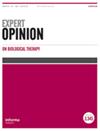白细胞介素基因疗法在头颈部癌症中的前景。
IF 3.6
3区 医学
Q2 BIOTECHNOLOGY & APPLIED MICROBIOLOGY
引用次数: 0
摘要
简介头颈部癌症(HNC),主要是头颈部鳞状细胞癌,起源于口腔、唇、喉和口咽等部位的鳞状上皮。手术、放疗和化疗等综合治疗方法往往在晚期无法奏效,因此需要创新疗法。讨论范围包括 HNC 中的关键 IL、各种基因治疗技术和给药方法。我们尤其关注 IL-2、IL-12 和 IL-24 基因疗法的应用,研究了它们在临床前研究和临床试验中的机制和结果。专家观点尽管基因组和免疫疗法取得了进展,但 HNC 治疗仍面临重大挑战,这主要是由于肿瘤微环境的免疫抑制性质和当前疗法的不良反应。IL 基因疗法的疗效取决于能否通过改进给药方法克服这些障碍,确保靶向性、肿瘤特异性基因表达。未来的策略应侧重于改进基因递送方法,并将 IL 基因疗法与其他疗法相结合,以优化疗效,减少毒性。本文章由计算机程序翻译,如有差异,请以英文原文为准。
The future of interleukin gene therapy in head and neck cancers.
INTRODUCTION
Head and neck cancer (HNC), primarily head and neck squamous cell carcinomas, originates from the squamous epithelium in areas like the oral cavity, lip, larynx, and oropharynx. With high morbidity impacting critical functions, combined treatments like surgery, radiation, and chemotherapy often fall short in advanced stages, highlighting the need for innovative therapies.
AREAS COVERED
This review critically evaluates interleukin (IL) gene therapy for treating HNC. The discussion extends to key ILs in HNC, various gene therapy techniques and delivery methods. We particularly focus on the application of IL-2, IL-12, and IL-24 gene therapies, examining their mechanisms and outcomes in preclinical studies and clinical trials. The final sections address IL gene therapy challenges in HNC, exploring solutions and critically assessing future therapeutic directions.
EXPERT OPINION
Despite advancements in genomic and immunotherapy, significant challenges in HNC treatment persist, primarily due to the immunosuppressive nature of the tumor microenvironment and the adverse effects of current therapies. The therapeutic efficacy of IL gene therapy hinges on overcoming these hurdles through refined delivery methods that ensure targeted, tumor-specific gene expression. Future strategies should focus on refining gene delivery methods and combining IL gene therapy with other treatments to optimize efficacy and minimize toxicity.
求助全文
通过发布文献求助,成功后即可免费获取论文全文。
去求助
来源期刊

Expert Opinion on Biological Therapy
医学-生物工程与应用微生物
CiteScore
8.60
自引率
0.00%
发文量
96
审稿时长
3-8 weeks
期刊介绍:
Expert Opinion on Biological Therapy (1471-2598; 1744-7682) is a MEDLINE-indexed, international journal publishing peer-reviewed research across all aspects of biological therapy.
Each article is structured to incorporate the author’s own expert opinion on the impact of the topic on research and clinical practice and the scope for future development.
The audience consists of scientists and managers in the healthcare and biopharmaceutical industries and others closely involved in the development and application of biological therapies for the treatment of human disease.
The journal welcomes:
Reviews covering therapeutic antibodies and vaccines, peptides and proteins, gene therapies and gene transfer technologies, cell-based therapies and regenerative medicine
Drug evaluations reviewing the clinical data on a particular biological agent
Original research papers reporting the results of clinical investigations on biological agents and biotherapeutic-based studies with a strong link to clinical practice
Comprehensive coverage in each review is complemented by the unique Expert Collection format and includes the following sections:
Expert Opinion – a personal view of the data presented in the article, a discussion on the developments that are likely to be important in the future, and the avenues of research likely to become exciting as further studies yield more detailed results;
Article Highlights – an executive summary of the author’s most critical points.
 求助内容:
求助内容: 应助结果提醒方式:
应助结果提醒方式:


